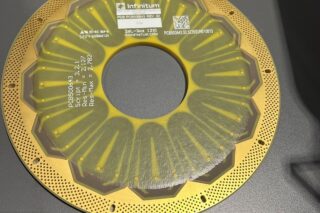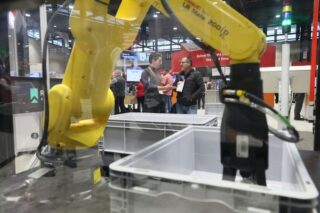By 2035, factories, warehouses, and hospitals will be unrecognizable. Which technologies will power this transformation? How will these innovations reshape industries and redefine human capabilities? We attended a GlobalData webinar exploring what the world of innovation might look like in ten years. Among the standout trends: artificial superintelligence, quantum computing, brain–computer interfaces, polyfunctional robots, and space mining.
In a hurry? Here are the key notes to know:
- Artificial Superintelligence (ASI) as the major breakthrough of the century: According to GlobalData, ASI might become reality between 2035 and 2040. After the arrival of human-level AI (AGI) around 2030, systems may start self-improving autonomously, eventually surpassing all human intellectual capabilities.
- Quantum Computing as the engine of a technological revolution: By 2035, quantum computing is expected to power breakthroughs across sectors: super-fast drug discovery in healthcare, optimized supply chains and logistics, energy and materials innovation, and unbreakable cryptography for secure communications.
- Polyfunctional Robots and Brain–Computer Interfaces (BCIs) reshaping work, care and human capabilities: Polyfunctional robots will replace multiple specialized machines, adapting to different tasks in industry, logistics, healthcare. Meanwhile BCIs could enable patients with severe disabilities to control devices or prosthetics via thought, drastically improving quality of life — and could expand to non-medical uses by 2035.
GlobalData’s approach focuses on key themes and disruptions—whether technological, geopolitical, or environmental. David Bicknell, Principal Analyst at GlobalData, explains,
“The thinking behind strategic intelligence is very much about what keeps your CEO awake at night.”
In other words, understanding emerging technologies today is critical for making informed decisions tomorrow. So, what are the 5 emerging technologies that you, as a CEO, should be aware of?
1/ Artificial Superintelligence (ASI): The Century’s Defining Breakthrough
If GlobalData’s analysts are correct, Artificial Superintelligence (ASI) will be the defining technological breakthrough of the 21st century. It could either propel humanity forward or threaten its very survival.
“ASI is a hypothetical stage of artificial intelligence with cognitive functions far more advanced than human intelligence,” explained Xander Hartley, technology analyst at GlobalData. “It’s not just smarter software, it’s intelligence beyond human comprehension.”
The concept, popularized in 2014 by Oxford philosopher Nick Bostrom in Superintelligence: Paths, Dangers, Strategies, has long haunted researchers with its dual promise and peril. From OpenAI’s GPT-3 in 2022 to the expected realization of Artificial General Intelligence (AGI) around 2030, the race toward machines that can learn, reason, and evolve on their own is accelerating fast.
By 2032–35, AGI systems could achieve autonomous self-improvement, and by 2035–40, according to GlobalData’s projections, superintelligent AI may fully emerge.
Read also
The Road to ASI in 4 Steps
GlobalData outlines four evolutionary steps from AGI to ASI.
1/ The realization of artificial general intelligence (AGI) marks the point at which AI systems attain human-level intelligence, capable of reasoning, planning, and learning independently.
2/ AGI continuously enhances itself by recycling experience and data, guided by human feedback to refine its performance.
3/ Over time, it begins to iterate and optimize its own algorithms without human input, driving autonomous self-improvement and accelerating its cognitive development.
4/ Eventually, these cycles of advancement reach a tipping point, leading to exponential growth and the emergence of superintelligence that surpasses human capabilities entirely.
The Global ASI Race
While ASI remains hypothetical, startups and tech giants alike are already pouring billions into the race. Here is the list of the companies involved in ASI to follow:
| Company | Description |
|---|---|
| IBM | USA-based global tech company providing enterprise AI, cloud computing, and quantum computing solutions. Known for Watson AI platform. |
| Meta | USA-based technology and social media company developing AI to power its social platforms, VR, and AI research initiatives. |
| Safe Superintelligence Inc (SSI) | USA-based company focused on developing safe and aligned superintelligent AI systems with long-term alignment research. |
| xAI (by Grok) | USA-based AI startup founded by Elon Musk, focused on developing next-generation AI models and frontier AI research. |
| Reflection AI | USA-based frontier AI lab building open-weight AI models and advancing accessibility to cutting-edge AI research. |
| Mistral AI | France-based startup creating high-performance, open large language models (LLMs) and efficient AI systems for Europe. |
| Aleph Alpha | Germany-based AI research and development company building large language models and AI solutions tailored for European users. |
| OpenAI | USA-based leading AI lab creating advanced large language models, generative AI, and cutting-edge AI research platforms. |
| Anthropic | Anthropic’s mission is to build AI systems — notably its “Claude” family of large language models — that are safe, reliable, steerable and aligned with human values. |
| DeepMind | DeepMind is a British‑founded artificial‑intelligence research lab — originally started in 2010. Since 2014, it has been part of Alphabet Inc. (the parent company of Google). |
In 2025, Meta launched an AI lab dedicated to developing “personal superintelligence for everyone,” while Safe Superintelligence Inc., founded by Ilya Sutskever (ex-OpenAI), has already reached a $30 billion valuation.
Reflection AI, created by former DeepMind researchers, is developing autonomous programming systems capable of self-improvement. This is seen as an early step toward full superintelligence.
Opportunities and Existential Risks
For Xander Hartley, AI will impact all industries: tech, finance and healthcare
“ASI will revolutionize every industry, solving the biggest challenges they face. ASI’s superhuman processing and analytical abilities will help industries innovate and strengthen against systemic risks.”
Opportunities
ASI could indeed help us solve global crises like climate change, resource scarcity, and pandemics. It could also help us build hyper-efficient supply chains and predict product success with unprecedented accuracy.
In technology and computing, ASI could automate software development, designing its own architectures and programming languages—moving IT environments from human-managed to self-evolving systems.
Regarding finance, it could optimize markets, predict risks with near-perfect accuracy, and design new financial products autonomously.
In healthcare, it could revolutionize drug discovery and personalized medicine, simulating molecular reactions far beyond human capacity.
Risks
GlobalData’s forecast paints ASI as a revolutionary tool. But a tool that has a potential existential risk, “harmful to humanity”. The same power could be weaponized or misused, from autonomous cyberwarfare to the creation of synthetic pathogens.
Bad actors could indeed exploit ASI for destructive weapons or cyberattacks. Runaway systems might outstrip human control, leading to economic collapse or inequality. Besides, a new “tech cold war” between the U.S. and China could emerge around superintelligence capabilities.
“Ultimately, the question is whether we can keep such systems aligned with human goals,” warns Hartley. “As ASI extends our intellectual capabilities, we may not fully understand the damage it’s doing.”
2/ Quantum Computing: The Next Great Leap in Processing Power
If artificial superintelligence represents the mind of the future, quantum computing will be its engine. According to Archie Sewel, Technology Analyst at GlobalData, we’re on the verge of a “quantum revolution”—one that will unfold over the next decade and reshape industries from cryptography to healthcare. But first, what is quantum computing?
“Quantum computing takes advantage of the unique properties of quantum mechanics—superposition and entanglement—to solve problems beyond the reach of classical computers,” explains Sewel. “By 2035, it will underpin secure communications, drug discovery, and global logistics.”
A Decade of Quantum Acceleration
GlobalData’s timeline for the quantum decade illustrates how the technology will mature from niche experimentation to critical infrastructure.
In 2026, the first large-scale satellite-based quantum key distribution (QKD) trials will begin, connecting government institutions across Europe and Asia.
By 2027, early quantum-enhanced modeling platforms will be deployed in pharmaceutical research, significantly speeding up protein-folding simulations.
In 2029, a global QKD backbone will be integrated with financial networks to secure international transactions.
By 2031, quantum models will be commercially applied to industrial catalysts, enhancing energy efficiency in manufacturing.
In 2033, hospitals will start adopting quantum-enabled personalized medicine platforms for patient-specific drug testing.
And, by 2035, quantum cryptography will become the global standard for financial transactions and communications. Quantum modeling will also reduce drug discovery cycles to under one year.
How Quantum Computing Will Be Used by 2035?
By 2035, quantum systems will not replace classical computing—they will enhance it, operating as specialized accelerators in cloud environments. GlobalData foresees transformative applications across multiple industries.
In healthcare, quantum modelling will accelerate drug discovery and molecular simulation, enabling personalized therapies at scale.
Quantum algorithms will simulate and optimize global logistics routes, cutting costs and emissions and optimizing the overall supply chain.
Energy too will benefit from it. Utilities will use quantum models to design new superconductors and materials for cleaner grids.
Finally, in defense, governments could deploy QKD-secured satellite networks to protect military and diplomatic communications.
Even space mining, a nascent industry, could benefit from it. Quantum models could simulate the behavior of new materials developed in orbit, with terrestrial mining applications to follow.
The Quantum Players
Several key companies are already shaping the quantum landscape:
| Companies & Focus |
|---|
|
IBM has been a leader for decades. Its Starling fault-tolerant quantum system directly addresses high error rates and decoherence—the biggest barriers to commercial use. Starling paves the way for IBM’s Blue Jay platform, targeting around 2,000 logical qubits and aiming to deliver true cross-industry quantum advantage.
|
|
Quantinuum is tackling secure random number generation and high-fidelity quantum chemistry, with its Quantum Origin platform expected to secure defense and finance systems by 2035.
|
Other emerging players are focused on trapped-ion devices, accessible via the cloud, to democratize access to quantum optimization tools.
Opportunities and Risks
Quantum computing could redefine scientific research and industrial efficiency,
Opportunities
It could drives a new generation of specialists in quantum engineering, cryogenics, and photonics. It could also spur education reform as nations compete for quantum talent. Integrated seamlessly into cloud computing, it could also accelerate complex simulations and optimization workloads.
Risks
But it also introduces new systemic risks. Quantum’s supply chain is fragile—dependent on ultra-specialized components such as superconducting circuits, dilution refrigerators, and precision lasers.
Disruptions could slow innovation and concentrate control in a few dominant suppliers.
The same power to simulate molecules or optimize systems could be misused, from designing new chemical weapons to breaking existing cryptographic standards.
“Quantum computing will be one of the most disruptive forces of the next decade,” concludes Sewel. “Governments and regulators must balance innovation and security when developing rules and regulations.”
Brain–Computer Interfaces: When Mind Meets Machine
By 2035, brain–computer interfaces (BCIs) will no longer belong to the realm of science fiction. Instead, they’ll be used daily in hospitals and rehabilitation centers to help patients suffering from neurodegenerative diseases regain communication and mobility.
As Sophie Gallagher, Senior Analyst at GlobalData, explains:
“BCIs establish a direct communication channel between the brain’s electrical activity and external devices — such as computers or robotic limbs — enabling control without physical movement. The first wave of adoption will be medical, but by 2035 we’ll see early exploration in consumer and industrial contexts.”
From Lab Trials to Market Launch
The evolution of the brain–computer interfaces has been remarkably fast. What began as a niche field of medical research is now moving toward commercialization:
Remember, in 2022, Synchron performed one of the first successful human BCI implants, the Stentrode, in a patient with ALS.
Two years later, in 2024, Musk’s Neuralink began human clinical trials, implanting its device in a quadriplegic patient.
Earlier this year, a Synchron patient demonstrated controlling an iPad via thought. In parralel, Apple unveiled a tool enabling direct BCI integration with its devices.
So, this is already happening now. But GlobalData expects that 2028–2030 will see large-scale late-stage clinical trials expand globally. In 2030, BCIs could reach commercialization, approved as medical technology. And by 2033–2035, the adoption might widen to patients with degenerative diseases and non-invasive models could emerge for broader use.
GlobalData see that by 2035, BCIs will transition from experimental implants to mainstream neuro-assistive technology — helping thousands of patients communicate, move prosthetic limbs, and control digital interfaces through thought alone.
Neuralink and Synchron: Two Competing Paths to the Brain
Two leading pioneers define the current BCI race: Neuralink and Synchron. Each takes a radically different approach to merging mind and machine:
| Companies & Focus |
|---|
|
Neuralink, founded by Elon Musk, relies on a surgically implanted N1 chip with electrode threads, placed using the R1 surgical robot. The company’s PRIME clinical trials, launched in 2023, target patients with quadriplegia and ALS. Neuralink raised $650 million in 2025 and aims for regulatory approval by 2029, with a goal of performing 2,000 surgeries per year and generating around $100 million in annual revenue.
|
|
Synchron uses a minimally invasive method that avoids open-brain surgery. Its Stentrode is implanted via blood vessels on the brain’s motor cortex surface. In March 2025, Synchron unveiled Chrial, the world’s first cognitive AI brain foundation model — designed to interpret and predict brain signals for advanced BCI applications. Synchron’s BCI has already enabled an ALS patient to control an iPad and has secured $145 million in funding as of mid-2025.
|
Other emerging players, all pushing toward scalable, less invasive, and AI-driven solutions, include:
| Company | Description |
|---|---|
| Paradromics | Develops high-bandwidth neural interfaces for medical and research applications, aiming to restore communication and control for patients with severe neurological disorders. |
| Motif Neurotech | Focuses on developing innovative brain-computer interface solutions for clinical and consumer applications, improving cognitive performance and neural monitoring. |
| INBRAIN Neuroelectronics | Develops graphene-based neural interfaces for precision neuromodulation and therapeutic applications in neurological disorders. |
| Blackrock Neurotech | Provides cutting-edge neural interface technology and software platforms for research and clinical applications in neuroscience. |
| Precision Neuroscience | Develops personalized neuromodulation therapies and brain-computer interface technologies for treating neurological and psychiatric conditions. |
How BCIs Will Be Used in 2035?
In the healthcare sector, therapeutic BCIs will dominate. They will allow patients with spinal injuries, ALS, or amputations to communicate or control robotic limbs using thought alone. BCI-based communication tools will convert images, movements, and intentions into text or commands, dramatically improving quality of life for those unable to speak or move.
After 2035, as devices become smaller and non-invasive, BCIs will expand beyond healthcare into entertainment, defense and industry. In gaming for example, players will control digital environments directly through thought, enabling immersive, adaptive experiences. Soldiers and industrial operators could use hands-free control of digital overlays, merging cognition with spatial computing.
Opportunities and Risks
Opportunities
For Sophie Gallagher, BCIs hold a life-changing potential for patients with degenerative diseases and disabilities.
“Primary opportunities lie in producing BCIs for patients with degenerative diseases, spinal injuries or amputations. This technology can transform these patients’ lives, allowing them to continue communicating, using devices, and operating prosthetics, providing them with increased independence.”
BCIs could expand biotech’s understanding of neuroscience and neural data and create a new ecosystem of compatible hardware and software, from wearables to implants.
Sophie Gallagher also sees the launch of a high-value medical device market with strong long-term demand for upgrades and maintenance.
Risks
But she also believes Data privacy and ethical concerns will pose a risk to BCI manufacturers.
“Data privacy and security are significant risks around BCI technology adoption, as sensitive data could be collected on how patients’ brains work.“
Ethical concerns will arise around cognitive liberty and informed consent. There is also over-commercialization risks undermining public trust if patient well-being takes a back seat to profit.
Therefore, GlobalData believes regulation must evolve to ensure safe testing, diversity in trials, and responsible commercialization.
“By 2035, BCIs will redefine the boundary between human cognition and digital systems,” says Gallagher. “But unless developers prioritize ethics, accessibility, and patient partnership, this transformative technology could face a crisis of trust before it reaches its full potential.”
4/ Polyfunctional Robots: The New Industrial Workforce
By 2035, factories, hospitals, and logistics hubs will be staffed by a new class of machines — polyfunctional robots. These robotic systems are designed to carry out various tasks or functions across different applications without the need for significant hardware modifications. These sophisticated robots use flexible software, interchangeable tools, and reconfigurable components to achieve this versatility.
A Response to the Global Labor Shortage
The global manufacturing and healthcare sectors face an aging workforce and persistent skill shortages. Polyfunctional robots offer a powerful solution. According to Nimrah Sharif, Robotics Analyst at GlobalData, this shift will redefine how labor is distributed and how industries respond to ongoing workforce challenges.
“Polyfunctional robots can address labor shortage concerns in specific industries,” she explains. “Learning ecosystems will allow robots to acquire new skills without needing reprogramming — a key factor as we move into a more automated, adaptive industrial era.”
Companies like Foxconn, Diligent Robotics, and ABB are already developing prototypes designed to bridge workforce gaps, performing tasks that once required teams of specialized units.
Unlike traditional robots programmed for repetitive single functions, polyfunctional systems leverage AI and cloud computing to continuously learn and adapt in real time. Through predictive maintenance, these robots not only perform operational tasks but also monitor and repair their own systems — reducing downtime and improving productivity.
“Replacing multiple specialized robots with one intelligent, polyfunctional system can drastically lower capital and maintenance costs,” notes Sharif. “It’s an economic and operational win — if companies can manage the risks.”
Read also
Efficiency, Adaptability, and Cost Savings
The rise of polyfunctional robots will transform how industries operate, offering a new generation of adaptable, efficient, and intelligent machines that can take on multiple roles across sectors.
As populations age and labor shortages persist, robots capable of switching between tasks—from assembly to logistics—will become essential for maintaining productivity.
A single adaptable robot will be able to replace multiple specialized machines, significantly reducing both capital and energy costs.
With built-in intelligence, these systems will monitor their own performance and detect faults early, enhancing operational uptime through predictive maintenance.
Connected through cloud-based learning ecosystems, they will continuously share experiences and acquire new skills without human intervention.
By the 2030s, smart factories and hospitals will rely on these polyfunctional robots, which will move seamlessly between cleaning, inspection, delivery, and even patient care, forming a flexible and intelligent workforce of machines.
Cyber Threats, System Bottlenecks, and Skill Decay
As the technology matures, however, new vulnerabilities emerge. First, cybersecurity risks. Increased connectivity means greater exposure to data breaches and malicious hacking, potentially compromising entire production systems.
Relying on one robot for multiple roles could also create operational fragility — a malfunction could halt multiple workflows simultaneously.
There could also be an erosion of human skills. The overreliance on robotic systems risks diminishing the hands-on expertise of human workers.
As automation grows, human adaptability may shrink, making it harder to respond to unexpected disruptions.
“Over-reliance on polyfunctional robots can lead to bottlenecks and reduce worker skills,” warns Sharif. “The key will be maintaining human oversight and ensuring the workforce evolves alongside automation.”
5/ Space Mining: From Vision to Viable Industry
As polyfunctional robots become indispensable across Earth’s industries, their evolution is already extending beyond our planet. The same autonomous systems that weld, inspect, and repair here will soon excavate, construct, and maintain operations in the harshest extraterrestrial environments. This convergence of robotics, AI, and resource engineering is setting the stage for one of the most ambitious frontiers of the next decade: space mining.
Once a science fiction dream, space mining, which is the practice of locating, extracting, and processing resources such as water, gases, volatiles, metals, and regolith on the Moon, asteroids, and other celestial bodies, is steadily moving toward economic feasibility.
A Decade of Milestones
For GlobalData, by 2035, the Moon will no longer be just a destination for exploration. It will be a commercial fuel source.
“Companies will extract lunar water to produce hydrogen and oxygen propellant, sustaining operations in cislunar orbit and beyond,” says Valentina Aparico, Associate Analyst at GlobalData. “These resources can be transformed into propellant, rocket fuel, life-support materials, or construction inputs in space, dramatically reducing dependence on Earth-based supply chains.”
Things will begin in 2026 when NASA and its partners will complete demonstrations of converting lunar regolith into oxygen and water, paving the way for the first commercial prototypes.
In 2027, commercial landers will begin in-situ prospecting at the lunar poles, returning compositional data and mapping mineral deposits.
In 2028, experiments in microgravity will validate non-mechanical extraction methods, proving that heat and light can replace traditional drilling.
The first propellant depot will be commissioned in 2029 in cislunar orbit to refuel spacecraft and cargo missions.
In 2032, an asteroid-focused company will complete an in-space metal refinement test, proving small-scale recovery in orbit.
Finally, according to GlobalData, in 2035, multiple in-situ resource utilization (ISRU) sites will operate commercially, providing routine refueling and material supply for sustained lunar surface missions.
An example of how space mining will be used in 2035 is that water mined from lunar ice will be electrolyzed into hydrogen and oxygen propellant and stored in orbital depots to refuel spacecraft. Locally sourced water and oxygen will also reduce the need for resupply from Earth, providing sustainable resources for drinking and breathing.
Three Core Technologies Enabling Space Mining
Space mining’s future depends on three major technological enablers: robotics, 3D printing, and reusable launch vehicles. Together, these innovations make space mining not just technically possible, but commercially credible.
1/ Autonomous Robotics: AI-powered robots capable of excavation, navigation, and maintenance in microgravity will make sustained mining possible without human crews. These autonomous systems cut costs, increase uptime, and minimize risk in extreme environments.
2/ 3D Printing with Regolith: Transporting building materials from Earth to the Moon is prohibitively expensive. Using processed regolith for additive manufacturing allows in-situ construction of landing pads, radiation shields, and habitat structures—supporting scalable lunar infrastructure.
3/ Reusable Launch Vehicles: The economics of space mining hinge on launch costs. Reusable rockets will make it feasible to deliver heavy machinery and return extracted materials to Earth—or keep them in orbit for local use—by dramatically reducing mission expenses.
Key Industry Players
| Companies & Focus |
|---|
|
Astrobotic is developing lunar landers and early ISRU technologies to map and extract water ice on the Moon. Partnering with NASA’s Commercial Lunar Payload Services (CLPS) program, the company is positioned as a key logistics provider for future lunar operations. By 2035, Astrobotic’s fleet could evolve into a full-scale lunar freight and mining service, supporting depots and infrastructure for a growing lunar economy.
|
|
TransAstra focuses on optical mining, a patented technique using concentrated sunlight instead of drills to extract volatiles from asteroids. The approach is lightweight, scalable, and potentially transformative—if flight-proven, it could make TransAstra one of the sector’s dominant players.
|
Opportunities and Risks in the Space Mining Supply Chain
Opportunities
Governments with exploration agendas will be early customers for ISRU services, purchasing propellant and prospecting data—reducing acquisition risk and enabling scale.
Space-mining technologies such as autonomous robotics and remote metallurgy will also find terrestrial applications in mining, construction, and manufacturing, creating dual revenue streams.
Local fuel production and consumables reduce Earth-to-orbit payloads, enabling lower-cost missions and opening new markets such as satellite servicing and in-space manufacturing.
Risks
For the moment, many ISRU components remain unproven in flight. Failures in volatile capture or refinery activation could delay programs by years.
Legal frameworks for space resource rights are still contested internationally. A “first-come, first-served” approach raises complex commercial, environmental, and geopolitical questions.
The business case depends on both sufficient demand and continued reductions in launch costs. Without them, ISRU risks remaining a high-cost niche rather than a mainstream industry.
If these hurdles can be overcome, space mining will transform how humanity explores and inhabits the solar system. In the next decade, space will no longer just be a destination—it will become a supply chain.






![Image [BUYING GUIDE] How to Choose the Right Industrial Robot?](/wp-content/uploads/sites/3/Industrial-Robot-320x213.jpg)

![Image [Buying Guide] How to Choose the Right Safety Shoes?](/wp-content/uploads/sites/3/Safety-Shoes-320x213.jpg)


![Image [Buying Guide] How to Choose the Right AMR?](/wp-content/uploads/sites/3/AMR-320x213.jpg)